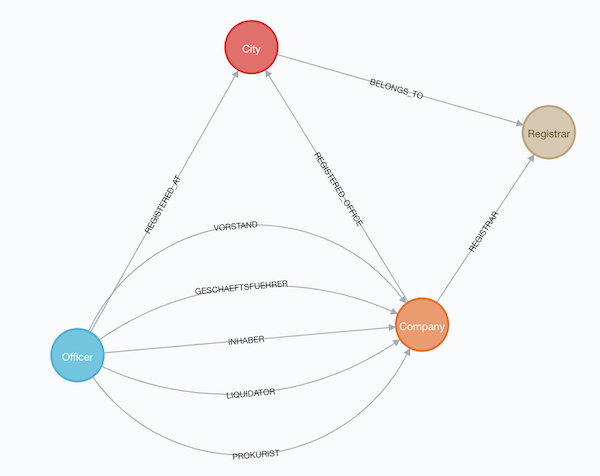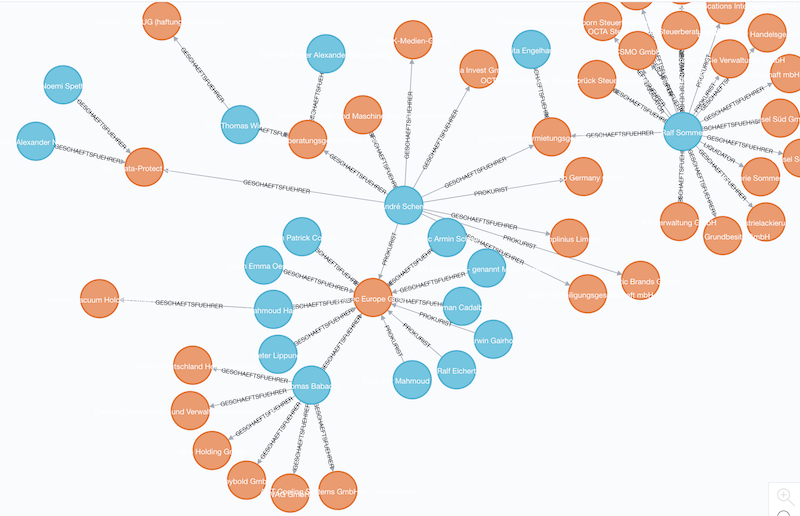Opencorporates recently made the German cooperate data publicly available. What better moment to learn how to import data into neo4j?
|
Note
|
There is an improved version of the import in a followup post. |
Utilizing the APOC extension, one can load the data from various sources (HTTP, file) in JSON, CSV or XML format.
The corporate data is available in JSONL format, which means that each line in the file is a JSON object. The lines are not bound together into an array.
After downloading and extracting the data, I had one file of about 4GB. A quick peek revealed the following structure:
{
"all_attributes": {
"_registerArt": "HRB",
"_registerNummer": "126167",
"additional_data": {
"AD": true,
"CD": true,
"DK": true,
"HD": false,
"SI": true,
"UT": true,
"VÖ": true
},
"federal_state": "Hamburg",
"native_company_number": "Hamburg HRB 126167",
"registered_office": "Hamburg",
"registrar": "Hamburg"
},
"company_number": "K1101R_HRB126167",
"current_status": "currently registered",
"jurisdiction_code": "de",
"name": "Verseau Industrial Machinery Trading GmbH",
"officers": [
{
"end_date": "2016-07-07",
"name": "Zahra Abdi Savejiani",
"other_attributes": {
"city": "Hamburg",
"dismissed": true,
"firstname": "Zahra",
"lastname": "Abdi Savejiani"
},
"position": "Geschäftsführer",
"type": "person"
}
],
"registered_address": "Sierichstraße 16, 22301 Hamburg.",
"retrieved_at": "2017-07-05T21:12:01Z"
}Each line contains all the data for one company as well as all the officers for that company. The role of the
officer is provided via the positionadditional_data
After playing around with the imported data, I decided that the CityRegistrarCompanyOfficer
Since Cypher does not currently allow to have dynamic types of relationships, I needed to know the values
of the position
sed '1s/^/[/; $!s/$/,/; $s/$/]/' de_companies_ocdata.jsonl | jq '.[]? | .officers | .[]? | .position' | sort -u
"Geschäftsführer"
"Inhaber"
"Liquidator"
"Persönlich haftender Gesellschafter"
"Prokurist"
"Vorstand"This is using the jqsed
How much data do we have?
wc -l de_companies_ocdata.jsonl
5305727 de_companies_ocdata.jsonlAbout 5.3 million lines aka companies. Throwing all of this at neo4j in one block would require a lot of memory as the JSON would need to be parsed and converted. Also, the transaction would be rather large, adding to the needed memory.
I decided to split the data into files, each containing 5000 companies. Also, each file needed to be a valid JSON file, so I concatenated the lines into an array:
gsplit -a6 -d --additional-suffix=.jsonl -l 5000 de_companies_ocdata.jsonl split/handel
for f in handel*; do sed '1s/^/[/; $!s/$/,/; $s/$/]/' $f > ../json/$f; rm $f; done|
Note
|
Needed |
We now have the data in digestible chunks and can start importing. I used python -m SimpleHTTPServer
As preparation I adjusted the memory for neo4j so that all the data would fit into it:
dbms.memory.heap.max_size=4G
dbms.memory.pagecache.size=6GSince I used the MERGE
create constraint on (n:Company) assert n.id is unique;
create constraint on (n:Officer) assert n.name is unique;The import script:
call apoc.periodic.iterate( # (1)
"unwind range(0, 1061) as filenb return filenb", # (2)
"call apoc.load.jsonArray('http://localhost:8000/split/json/handel'+substring('000000',size(filenb+'')) + filenb +'.jsonl')
yield value with apoc.convert.toMap(value) as c # (3)
merge (company:Company {id:c.company_number}) on create set company.name = c.name,
company.status = c.current_status, company.jurisdictionCode = c.jurisdiction_code,
company.address = c.registered_address, company.registerArt = c.all_attributes._registerArt,
company.registerNummer = c.all_attributes._registerNummer,
company.registerOffice = c.all_attributes.registered_office,
company.nativeCompanyNumber = c.all_attributes.native_company_number,
company.previusNames=[p IN c.previous_names | p.company_name],
company.federalState = c.all_attributes.federal_state, company.registrar = c.all_attributes.registrar
foreach (o in c.officers |
merge (officer:Officer {name:o.name}) on create set officer.firstName = o.other_attributes.firstname,
officer.lastName = o.other_attributes.lastname, officer.registeredOffice = c.all_attributes.registered_office
foreach(i in case when o.position = 'Geschäftsführer' then [1] else [] end |
merge (officer)-[r:GESCHAEFTSFUEHRER]->(company)
on create set r.dismissed=o.other_attributes.dismissed,
r.startDate = date(o.start_date),
r.endDate = date(o.end_date))
foreach(i in case when o.position = 'Persönlich haftender Gesellschafter' then [1] else [] end |
merge (officer)-[r:GESCHAEFTSFUEHRER]->(company)
on create set r.dismissed=o.other_attributes.dismissed,
r.startDate = date(o.start_date),
r.endDate = date(o.end_date))
foreach(i in case when o.position = 'Inhaber' then [1] else [] end |
merge (officer)-[r:INHABER]->(company)
on create set r.dismissed=o.other_attributes.dismissed,
r.startDate = date(o.start_date),
r.endDate = date(o.end_date))
foreach(i in case when o.position = 'Prokurist' then [1] else [] end |
merge (officer)-[r:PROKURIST]->(company)
on create set r.dismissed=o.other_attributes.dismissed,
r.startDate = date(o.start_date),
r.endDate = date(o.end_date))
foreach(i in case when o.position = 'Vorstand' then [1] else [] end |
merge (officer)-[r:VORSTAND]->(company)
on create set r.dismissed=o.other_attributes.dismissed,
r.startDate = date(o.start_date),
r.endDate = date(o.end_date))
foreach(i in case when o.position = 'Liquidator' then [1] else [] end |
merge (officer)-[r:LIQUIDATOR]->(company)
on create set r.dismissed=o.other_attributes.dismissed,
r.startDate = date(o.start_date),
r.endDate = date(o.end_date))
)", {batchSize:1, parallel:false})-
apoc.periodic.iterate -
this just produces all the values between 0 and 1061 (the number of created via split above)
-
construct the URL to load the JSON and parse it into a map
The foreach
The import of the 4GB data took on my MBP about 10 minutes. Not toobad.
With the data in place, one can now start exploring. The image right at the top shows the companies of some far-right Germans.
Searching for a company called "Schulenberg & Schenk" I came up with the mesh of companies below. They are a law firm that I received a letter from a few years back, claiming some copyright infringement. They are 'famous' in Germany for sending out adhortatory letters on behalf of the pornographic industry. I did win that lawsuit.
It would be cool to enrich that graph with data from other sources. I was looking for data about german politicians, but could not find any. If you know any public available sources, please ping me via Twitter



